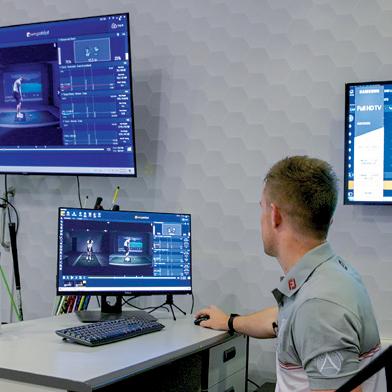
5 minute read
Little Pains, Big Gains
change your ball position
▶ To set up in the rough, pick a club based on what you see. If there’s nothing in front of the green, I’ll use less club and hit a shot that lets the ball run on, taking advantage of the decrease in backspin with shots from the rough. I then set up with the ball no farther forward than centre in my stance (left). Getting the ball position right is really important in the rough. You want to catch as much of the ball—and as little of the grass—as possible. Playing it more forward puts a lot of grass in the way of the ball, reducing your control.
read the lie
▶ To figure out how the ball is going to come out of the rough, first look at how much grass is behind it. Whether the ball is nestled down or propped up (known as a flyer lie), if you catch too much grass, it will come off the club hot and spin less. The reason is that the grass interferes with the grooves on the clubface, and those grooves create the spin you need to control distance. With no spin, you get those shots that fly far and run hard when they land. The ball might not always react this way, but you should be aware of the potential for a flyer. If there isn’t a lot of grass, you can expect a much more typical ball flight but still less spin than a shot from the fairway or first cut.


come in steeper
▶ Another key in taking less grass is getting steeper in my swing than normal (left and above) . A swing that’s more vertical helps make sure you catch the ball solid, and the easiest way to create that angle of attack is by shifting your weight forward at address. If you pre-set your weight to favour your front foot, it will naturally make your swing steeper without having to do anything else.
and stay down
▶ There’s one more thing you need to do to make solid contact—stay down through impact (below). Your instinct might be to rise out of your address posture, trying to use your body to help lift the ball. But when you do that, you’re probably going to catch too much grass and chunk it, or catch the ball on the upswing and blade it. One technique that can help you out of the rough, especially with a flyer lie, is to play a punch shot. Address the ball just back of centre in your stance with the shaft of your club leaning toward the target. Make a swing where you feel like you’re punching down on the ball with an abbreviated follow-through. If you want to get it to the green from the rough, it’s all about hitting these shots as solidly as you can.

Swing Catalyst 3D motion plate technology could be the key to ridding your game of those frustrating little fats and thins around the green
IT IS NOT ONLY the full swing that can be improved by an understanding of ground forces and pressures. They’re facets of utmost importance in the short game as well although should be viewed, and the moves implemented, diff erently to the long game. In a nutshell, the shorter the shot, the smaller forces and movements we should see.
When amateurs approach me with inconsistent ball striking with their chipping, we head straight to the Swing Catalyst force plate. A lot of the time the issue can be linked to their interaction with the ground and with the Swing Catalyst technology at Dubai Creek Golf & Yacht Club, it’s easier than ever to show them what changes need to be made.
The low point of the swing is a big factor and this can be aff ected by the pressure trace reading. The reading should favour and stay the majority of the time on the lead leg WATCH THE VIDEO

▶ Scan the QR Code to watch Matt bring this lesson to life.
during the shot and have very little lateral movement compared to a full swing.
The pressure trace pattern I see in amateurs who struggle with chipping tend to have too much lateral movement on to the trail and then back onto the lead leg during the shot. Something that can be visually checked is the head movement of the player. That is achieved by drawing a line on the lead side of the head at set up (see below, right) and can be used as a cross reference during the swing. But this is not a 100 percent cure.
Other aspects that are vital to consistent chipping are mobility, stability and strength - all infl uences that can impact short game ability. A “TPI” (Titleist Performance Institute) physical screen assessment is something I always take my students through as there may be a single leg balance, glute strength or even a disassociation issue between the upper and lower body that may have some influence in the swing characteristics. If you have having issues getting up and down consistently around the greens, consider a visit to DCGYC’s Peter Cowen Golf Academy to add the latest technology to your game improvement ambitions. You won’t be disappointed. —WITH KENT GRAY

Matthew Brookes is a PGA teaching professional and golf specifi c fi tness trainer at Dubai Creek Golf & Yacht Club’s Peter Cowen Academy Dubai.
Are you making the most of your potential? With the use of our new 3D motion plate technology from Swing Catalyst, combined with TPI and Bio Swing screenings, we can tell you if you are!










